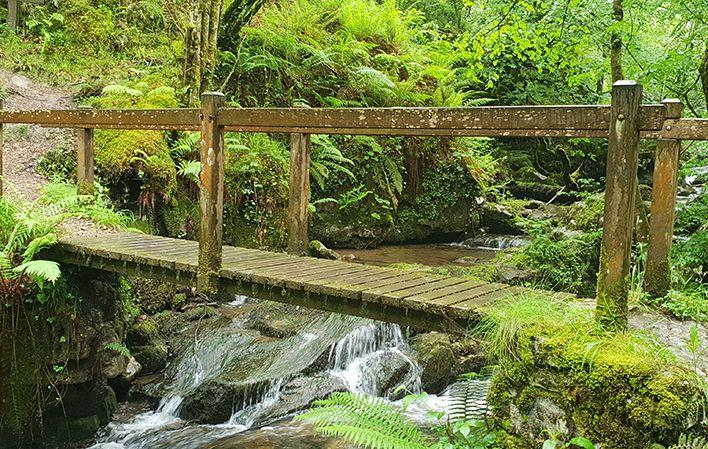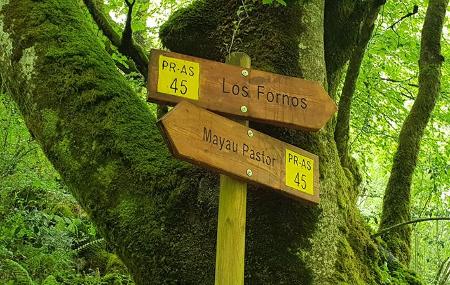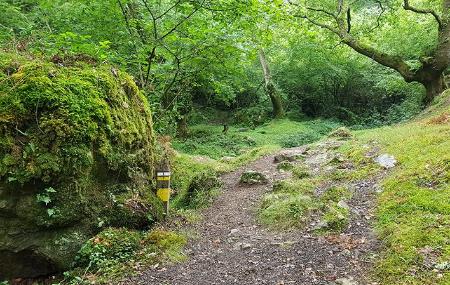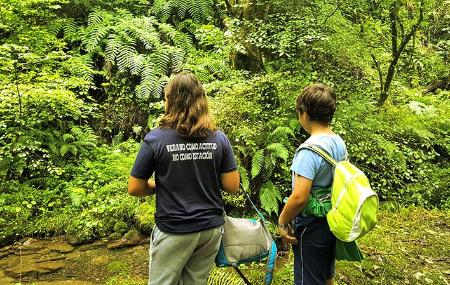
Foces del Río Pendón
- Address Nava Eastern Asturias
- Distance Distance: 8,5 kms
- Difficulty Difficulty: Short
- Code Code: PR45
- Altitude Altitude: 633 m.
- Unevenness Unevenness: 455 m.
- On foot On foot: 3 h. 30 min.
- Start point Start point: Fuentesanta/ῌuentesanta
- Route type Route type: hiking
- Tour type Tour type: Circular
- Layout of the route Layout of the route: Download kml, Download gpx
Info
History, geology, forests and landscapes come together on this route to make us enjoy it with all five senses.
A route to see the landscape of the plain, towards Nava, Siero and Sariego; listen to the continuous murmur of the river as we approach it; feel the smell of the wet ground, caress the tree trunks and the moss that covers them, and sit down to enjoy a good sandwich in the forest.
History is provided by the medieval palace and tower that once belonged to the Álvarez de las Asturias (where tradition has it that Doña Jimena, wife of the Cid Campeador, was born), and geology gives us, excavated by the river, the Pendón gorge, like a small Cares.
Ten kilometres of a circular route in which we can highlight the presence of tropical ferns, such as the píjara, which were isolated by the glacial era and have survived until the present day.
And, of course, a route where we can see deer on the steepest slopes, for which we will have to be very attentive.
Route
Fuentesanta/ῌuentesanta - Fuentesanta/ῌuentesanta 8
To get to the start of the route, take the N-634 towards Nava, turning off to the right 2 km before reaching the town, following the sign to Fuentesanta/ῌuentesanta.
We start from the Fuensanta mineral water bottling plant, where we leave our car, and cross the bridge over the river Pra. The path starts there, and there is a sign with information about it.
We take a path to the right. A few metres further on we come to a fork, where we turn right again, towards Tabléu; if we choose to go left, we go straight to the Fornos, which will be our way back.
After 2 kilometres from the start of the route, we have beautiful views of the Sierra del Sueve mountain range and the mountains of the Nava council, as well as the different villages in the area and the Palacio de la Ferrería. After walking another kilometre and a half, we find ourselves in the Tabléu area, where we can see some of the "brañas".
We will have walked for about 4.4 kilometres when we reach the famous Mayáu Pastor; here we can see the huts used by the shepherds of the area and their livestock. Behind there is a small fountain, where we can refresh ourselves.
Half a kilometre further on is the highest part of the route, from where we have a wonderful panoramic view of the fountains of the Pendón river. We start to descend towards them along the old path of "Les Vueltes".
After crossing several bridges, one of them the Pendón bridge, at kilometre 6 we walk along a path carved into the rock itself parallel to the river. This is the most beautiful part of the route, as we enter fully into the gorges, surrounded by a forest of oak and centenary beech trees.
If we go approximately one and a half kilometres further from the previous point, kilometre 7.6, we will find ourselves in the area known as Les Mecedores, where we can see a beautiful waterfall that falls against the path itself.
About 500 metres further on, kilometre 8.10, we are at the Los Fornos pass; from here we descend towards the initial crossroads, the end point of our route, surrounded by centenary chestnut trees. A few kilometres further on, we are back at the crossroads where we started the route, and we continue downhill until we reach the car park of the Fuensanta bottling plant.
Along this route we can find different plant species, such as Aconitum vulparia, commonly known as yellow aconite or matalobos. It is a toxic plant, like the other species of the genus. It contains a mixture of alkaloids, mainly licaconitine, which causes serious nervous and cardiac disorders, and its poison can pass through the skin just by carrying it in the hand. Therefore, caution is advised not to pick or touch any plant formation.




